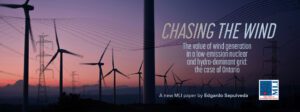This article originally appeared in National Newswatch.
By Edgardo Sepulveda, September 23, 2024
Ontario taxpayers subsidize wind and solar electricity generation by a staggering $3.2 billion each year, thanks to the fiscal legacy of the now-repealed Green Energy Act (GEA). Going forward, the provincial government must ensure that it pays a fair price for wind power.
My new report, “Chasing the Wind,” published by the Macdonald-Laurier Institute, tells the economic story of wind generation in Ontario. It explains how it contributed to this fiscal mess and how to avoid the mistakes of the past.
The GEA was a highly controversial piece of legislation at the local and provincial levels. It gave the province the power to override local opposition to wind turbine installations and contributed to an unprecedented increase in electricity prices. The McGuinty Liberal government set high wind prices and fixed them for 20 years.
Electricity prices increased with wind and solar generation, as did political anger. In an effort to avoid political defeat, the Wynne Liberal government introduced multi-billion-dollar subsidies in 2017 that now appear to be a fixed part of provincial budgets. No other province has subsidized its electricity sector by this much for so long – and it’s a mistake.
Since 2018, the Ford Conservative government has increased subsidies even further and made its mark on the electricity file. After repealing the GEA, the government took the necessary steps to ensure that nuclear and hydro remain the backbone of one of the lowest-emission large grids in the world, with increased investment in these sectors. The Ontario government recently announced a new procurement process, including for wind, to round out its generation mix.
From what we know of the process, the provincial government will clearly not repeat the mistakes of the GEA. It has announced that the procurement will be competitive and that it will work with municipalities to ensure that they are willing hosts for wind farms.
My report shows how to take this policy further by estimating the value of wind in Ontario using cost benefit analysis (CBA). The report’s analysis of hundreds of thousands of data points shows that wind had a negative cost-benefit (value) for the years 2020–23, even after accounting for climate benefits. Why?
First, we are still paying exorbitant legacy wind prices of $151/MWh. Second, the climate benefits are modest because the data shows that wind displaces gas generation only about half the time. The rest of the time, wind is less valuable because it displaces other low-emissions resources (hydro) or because it is misaligned with demand and must be exported or curtailed.
We cannot control the weather, so the only thing we can do to ensure that wind is cost-beneficial is to make sure that the price is right. My report argues that the going-forward price should be no higher than $46/MWh.
This analysis is crucial for informing the details of the upcoming procurements, which are still to be determined by the Independent Electricity System Operator (IESO), the Crown corporation that operates the electricity market in Ontario. One approach that should be considered is setting a maximum price that participants may bid. In this case, a policy of competitive procurement is not enough. It is essential that the private cost of wind be aligned with its broader public value, as measured by CBA. The provincial government should direct IESO to set a maximum bid price of $46/MWh for wind.
Many claim that private wind costs have decreased to the point that wind no longer requires large subsidies. This price will test that claim while drastically reducing government subsidies.
The Ford government now has an opportunity to get wind “right” in Ontario by ensuring that it is accepted locally and that the Province pays no more than it’s worth.
Edgardo Sepulveda is a Toronto-based regulatory economist with more than thirty years of experience in the telecommunications and electricity sectors. His new report, Chasing the Wind, was published by the Macdonald-Laurier Institute.







